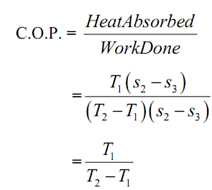Isentropic Expansion Process:
Now the air is expanded isentropically as indicated by the curve 3-4 on p-v & T-s diagrams. The pressure of air reduces from p3 to p4, particular volume enhances from v3 to v4 & temperature reduced from T3 to T4. We know that throughout isentropic expansion, no heat is absorbed or discarded by the air.
Isothermal Expansion Process:
Now the air is expanded isothermally (that is at constant temperature, T4 = T1) as indicated through the curve 4-1 on p-v & T-s diagrams. Throughout this procedure, the pressure of air reduced from p4 to p1 and particular volume enhance from v4 to v1. We know that the heat absorbed by the air throughout isothermal compression per kg of air,
q4-1 = area 4-1-2'-3'
= T4 (s1 - s4)
= T4 (s2 - s3)
= T1 (s2 - s3)
We know that work completed throughout the cycle per kg of air
= Heat rejected - Heat absorbed
= q2-3 - q4-1
= T2 (s2 - s3) - T1 (s2 - s3)
So, coefficient of performance of the refrigeration system functioning on reversed Carnot cycle,
